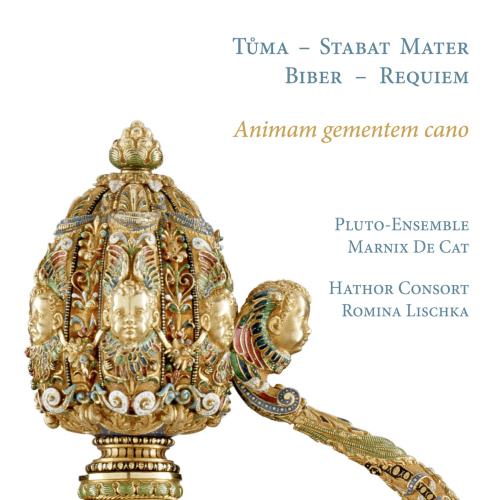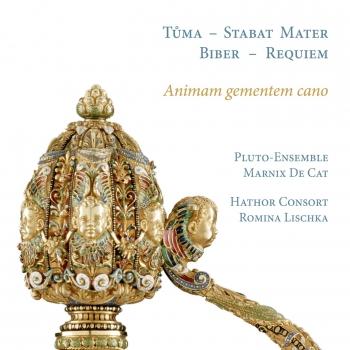
Animam gementem cano Pluto-Ensemble & Marnix De Cat, Hathor Consort & Romina Lischka
Album Info
Album Veröffentlichung:
2020
HRA-Veröffentlichung:
04.09.2020
Label: Ramée
Genre: Classical
Subgenre: Chamber Music
Interpret: Pluto-Ensemble & Marnix De Cat, Hathor Consort & Romina Lischka
Komponist: Heinrich Ignaz Franz Biber (1644-1704), Johann Heinrich Schmelzer (1620-1680), Frantisek Tuma (1704-1774), Andreas Christoph Clamer (1633-1701)
Das Album enthält Albumcover Booklet (PDF)
- Heinrich Ignaz Franz Biber (1644 - 1704): Requiem in F Minor, C 8:
- 1 Requiem in F Minor, C 8: I. Introitus. Requiem (Adagio) & Kyrie 04:41
- 2 Requiem in F Minor, C 8: II. Sequentia. Dies Iræ - Lacrimosa 07:04
- 3 Requiem in F Minor, C 8: III. Offertorium. Domine Jesu - Quam olim Abrahæ 04:30
- 4 Requiem in F Minor, C 8: IV. Sanctus - Osanna - Benedictus 04:21
- 5 Requiem in F Minor, C 8: V. Agnus Dei & Communio 05:11
- Johann Heinrich Schmelzer (1620 - 1680):
- 6 Sonata IX in G Major 04:43
- Andreas Christophorus Clamer (1633 - 1701): Partita I in E Minor:
- 7 Partita I in E Minor: I. Lamento (Adagio quanto si può) 05:36
- 8 Partita I in E Minor: II. Gigue (Allegro) 01:14
- 9 Partita I in E Minor: III. Sarabanda (Adagio, Adagio) 02:55
- 10 Partita I in E Minor: IV. Saltarello (Alla breve) 00:46
- Heinrich Ignaz Franz Biber:
- 11 Sonata VIII à 5 in G Major 04:51
- František Ignác Antonín Tůma (1704 - 1774): Stabat Mater in G Minor:
- 12 Stabat Mater in G Minor: I. Stabat Mater (Larghetto) 02:39
- 13 Stabat Mater in G Minor: II. O quam tristis 01:36
- 14 Stabat Mater in G Minor: III. Quis est homo (Andante) 00:46
- 15 Stabat Mater in G Minor: IV. Pro peccatis (Larghetto) 00:54
- 16 Stabat Mater in G Minor: V. Eia Mater (Andante) 00:41
- 17 Stabat Mater in G Minor: VI. Sancta Mater 01:34
- 18 Stabat Mater in G Minor: VII. Fac me tecum (Larghetto) 03:55
- 19 Stabat Mater in G Minor: VIII. Fac me plagis 01:45
- 20 Stabat Mater in G Minor: IX. Fac ut animæ 01:53
Info zu Animam gementem cano
Neuentdeckte Kostbarkeit: Das Pluto-Ensemble und das Hathor Consort präsentieren hier auf RAMEE gemeinsam die Weltersteinspielung des unlängst wiederentdeckten Stabat Mater von František Tůma (1704–1774). Dieses offensichtliche Spätwerk des Komponisten – und nun die fünfte seiner Vertonungen der Sequenz – lag lange vergessen in der Klosterbibliothek von Ottobeuren, ehe die Kostbarkeit von Marnix de Cat (künstlerischer Leiter des Pluto-Ensembles) dort wiederentdeckt wurde. Für die Einspielung wurden ihm das expressive Requiem f-moll von H. I. F. Biber und Werke von Johann Heinrich Schmelzer und Andreas Christophorus Clamer zur Seite gestellt. Eine rundum gelungenes Album für Liebhaber musikalischer Entdeckungen geistlicher Musik des Barock.
Pluto-Ensemble
Hathor Consort
Marnix de Cat
Romina Lischka, Leitung
Pluto-Ensemble
Inspirator, conductor, and singer Marnix De Cat founded the Pluto-ensemble to perform music based on Truth of the human being, with a message of beauty and joy. In times of mondial disturbance the idea is to have a good influence both on musicians and public, by programming, playing and explaining music in its context. Let's eliminate the disturbance by exploring and working on the cause, this means our own self...
The name comes from the 'dwarf'-planet 'Pluto', the third mistery-planet of the Aquarius-era. After Uranus and Neptunus, influencing the heart and the mind, Pluto is the re-creator of man as a higher being.
Each program has different needs of singers and instruments. For a couple of projects the ensemble works together with the Hathor Gamba-Consort.
With its inspirator Marnix De Cat grounded in the early tradition of the Franco-Flemish Polyphony, it also wants to open other musical fields.
From the 14th century Ars Nova and Ars Subtilior, over the Golden Renaissance from Flanders to Italy, France, Germany and England, Polyphony keeps up its remarkable and exciting way to tease the ears. Over classical polyphonic structures we also pass the Barock-period and meet Fux, Biber, Tuma, Bach... Ending in contemporary polyphonic music in minimal and repetitive music.
All the way the sound of polyphony sets each individual musician at a point of surrender to the unity of the sound, keeping his own flow and identity. What a joy to join that music making, what a feast to listen to!
The Hathor Consort
which takes its name from the Egyptian mother goddess Hathor, was formed by Romina Lischka in 2012. Under her artistic direction, this string ensemble is dedicated to performing music from the Renaissance and Baroque centered around the viola da gamba. Simultaneously, the group is also interested in exploring new expressive possibilities of the refined, European chamber music repertoire in multi-disciplinary and intercultural concert forms where early music from other cultures combine with modern music, world music and dance.
Their first CD Lachrimae, featuring music of John Dowland, was released by the Belgian label Fuga Libera in 2014 and was enthusiastically received by the press. Their program of the same name combines Dowland's music with six interludes by the Belgian composer Annelies van Parys and choreography by the Belgian dancer Femke Gyselinck. Dhrupad Fantasia, the consort's newest project, combines the oldest form of North Indian classical music (the dhrupad) with music from 16th century England. Music from the court of the Mogul Akbar the Great and the court of Queen Elizabeth I merge together to form a new musical language, where compositional and improvisatory elements from both musical traditions are combined.
Because an understanding of the voice is necessary to comprehend the instrumental polyphony of the gamba consort, the Hathor Consort works together regularly with soloists and vocal ensembles such as Marnix De Cat's Pluto Ensemble and Collegium Vocale Gent, directed by Philippe Herreweghe.
With its multi-facetted programming, the Hathor Consort has been invited to numerous festivals and concert halls throughout Europe, including the Vienna Konzerthaus, Warschau Filharmonie, Bozar Brussel, London's Wigmore Hall, Cologne Philharmonie, Philharmonie Essen, Utrecht Early Music Festival, MA Festival Brugge, Musikfestspiele Potsdam, Opéra de Rouen, Muziekcentrum De Bijloke Gent and the York Early Music Festival.
Romina Lischka
studiert Viola da gamba an der Schola Cantorum Basiliensis in Basel, Schweiz bei Paolo Pandolfo, Solistendiplom 2006 mit Auszeichnung und anschliessend mit Philippe Pierlot am Königlichen Konservatorium Brüssel, Belgien, Master 2008 mit Auszeichnung.
Seit 2008 spielt sie als Solistin mit Ensembles wie Collegium Vocale Gent (Philippe Herreweghe), Gli Angeli Genève, Il Gardelino,etc. Ihre Konzertaktivität führt sie zu renommierten Festivals und Konzerthäusern in Europa, Russland, Asien, Kanada, Nord- und Südamerika.
2012 spielt Romina in der Premiere von George Benjamin's Oper Written on Skin im Festival Aix -en-Provence. Seither ist sie der Produktion an die Opéra Comique in Paris, an das Bolshoi Theater in Moskau, mehreren Tourneen mit dem Mahler Camper Orchestra in Europa (Royal Opera Madrid, Barbican London, etc). und dem Shanghai Symphony Orchestra in China gefolgt.
Für die Saison 2012/13 wählt BOZAR und Concertgebouw Amsterdam sie als ECHO Rising Star für die Kategorie Alte Musik aus. In diesem Rahmen tritt sie als Solistin in einem Grossteil der europäischen Konzerthäuser auf. Ihre erste CD Pièces de viole de Sieur de Machy erhält einen Diapason 5. En Suite - Marin Marais & Ste. Colombe, erhält den Klara Preis 'beste klassische CD von 2015'.
Romina ist auf zahlreichen CD Aufnahmen bei den Labels Coro, Flora, Ricercar, Christophorus, Musica Ficta, Fuga Libera, Paraty, Phi und Ramée zu hören.
Neben ihrer Tätigkeit als Gambisten studiert sie nordindischen klassischen Gesang, Stil Dhrupad, von 2006 bis 2010 (Bachelor) am Konservatorium in Rotterdam, Holland (World Music Department), sowie in Delhi und Pune, Indien mit Ustad Fariduddin Dagar und Uday Bhawalkar.
2012 gründete sie ihr Hathor Consort, das sich dem Consort Repertoire der Renaissance und des Barock, sowie Weltmusik und zeitgenössischer Musik widmet.
2018 erhält sie den VRT-Klara Award Solist des Jahres. In der Saison 2019-20 ist sie Portrayed Artist von Bozar.
Booklet für Animam gementem cano









